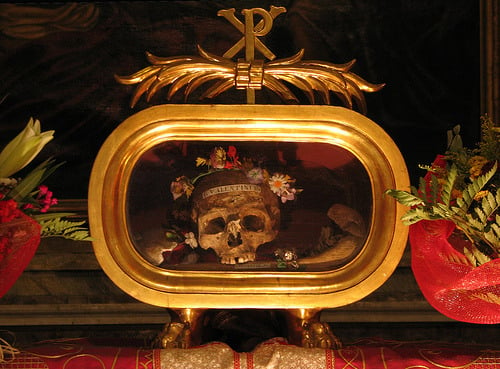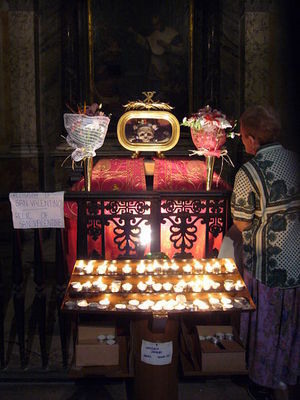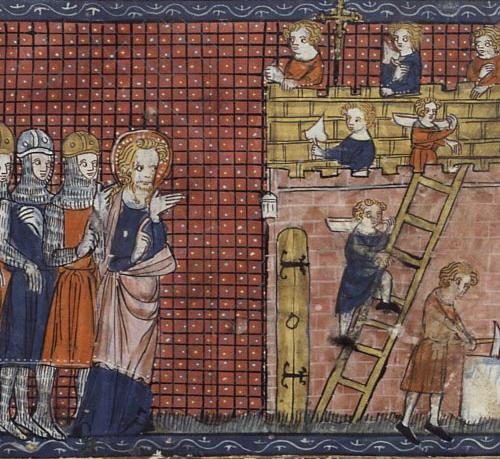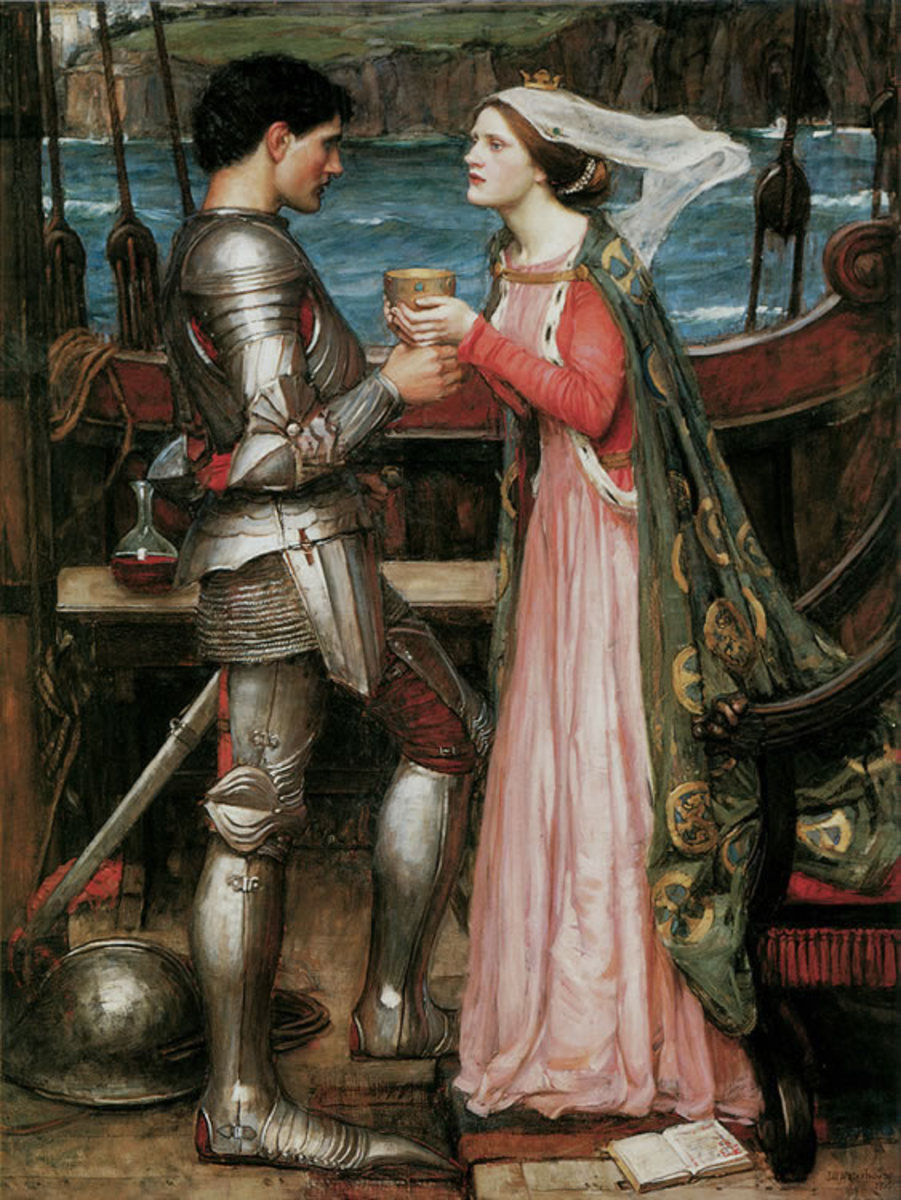All About St. Valentine's Day

You would have to be living under a rock to not know what St. Valentine’s Day is in this day and age. Every February 14th, sweethearts and couples around the world get together and declare their love for one another. A time of romance for lovers when greeting cards and chocolate is exchanged. It is an affectionate, loving time of the year. The thing is, there are so very few people who actually know the truth about Valentine’s Day. Why is it associated with love and romance? Why celebrate it on February 14th? Why exchange chocolate, roses, and other gifts between lovers? Just who was St. Valentine?
The Men that were St. Valentine
The truth is that no one really knows just who the specific St. Valentine celebrated on February 14th was. There have been many saints named “Valentine” who were martyred during the time of the Roman Empire. The most commonly regarded one was a third-century man named Valentinius. Nobody knows where and when he was born or how he lived his life. Traditionally, he is said to have been martyred around 269 and that he was buried at a cemetery on the Via Flaminia close to the Milvian Bridge to the north of Rome on February 14th of that year.
It was not easy to be a Christian in third century Rome. Martyrdom was always a constant threat to the followers of Christ as Christians refused to recognize any divinity within the emperor. There were several men named Valentine who were martyred for their faith during this time and most scholars nowadays believe the “St. Valentine” of legend to be an amalgam of at least three of these men. According to The Catholic Encyclopedia, at least two of these “St. Valentines” are buried in the Via Flaminia cemetery—one was a Roman priest, the other the bishop of Interamna (modern Terni). However, there are some sources that suggest that these two may have in fact been a single person. The official biography of St. Valentine states that he was the bishop of Interamna who was imprisoned and tortured in Rome while he was temporarily staying there (hence considered a Roman priest in some sources) on February 14th, 273, under the persecution of Emperor Aurelian; if not under Aurelian, then under his predecessor Claudius II around 269. However, there are again other sources that state that the Valentine of Rome was another martyr from two hundred years later in 496. Valentine of Terni’s skull is exhibited in the Basilica of Santa Maria in Cosmedin, Rome.



Whatever is the truth about the man Valentine has just about entirely been supplanted by the legends that have developed concerning him. One such popular legend that developed concerning him was for the reason for his imprisonment: performing weddings for soldiers who were forbidden to marry in addition to ministering to persecuted Christians. An embellishment of this legend is that he wore a purple amethyst ring, which was a custom of Christian bishops, with an image of cupid on it: soldiers would recognize him because of the ring and would thus request that he perform a wedding for them. Another legend that arose concerning him was how apparently he healed the daughter of his jailor, Asterius of blindness while imprisoned. Further embellishment to the legend states that shortly before his execution, he sent her a letter signed “Your Valentine” as a farewell. Another embellishment in the legend of him performing weddings for soldiers, Valentine was said to have cut hearts from parchment and give them to the soldiers and other persecuted Christians.
The Catholic Church eventually declared February 14th, the supposed date of Valentine of Terni’s martyrdom, to be the saint’s official feast day. It was in 496 that Pope Gaius I officially declared February 14th as Valentine’s Day. For the Eastern Orthodox Church however, St. Valentine’s feast day is instead July 30th. St. Valentine was the patron saint of engaged couples and happy marriages amongst other things. Perhaps that is why Valentine eventually came to be associated with romantic love. There are some authors who claim that February 14th was declared to be Valentine’s Day so as to supersede the Roman fertility feast of Lupercalia. However, there is virtually no evidence in existence to suggest this is true. It wasn’t until the Medieval Period when Valentine’s Day started to come to be associated with romantic love.
The Early History of St. Valentine's day
Geoffrey Chaucer was perhaps the first author to ever place Valentine’s Day in a romantic light. In his 1382 poem Parlement of Foules he wrote:
For this was on seynt Volantynys day
Whan euery bryd comyth there to chese his make.
[“For this was on St. Valentine's Day, when every bird cometh there to choose his mate.”]
This particular poem was written in honor of the anniversary of the engagement of Richard II of England to Anne of Bohemia. It should be noted that it is highly unlikely that the “Valentine’s Day” mentioned in the poem is February 14th as English birds do not mate in mid-February. Most likely, the date was around May 3rd in celebration of yet another man named Valentine, a bishop of Genoa who died around 307. This would also fit with the fact that the marriage treaty between Richard II and Anne was signed on May 2nd, 1381. It wasn’t until 1537 that King Henry VII of England declared February 14th to St. Valentine’s Day. There were other contemporary poets who associated Valentine’s Day with love birds, but Chaucer was most likely predated all of them.
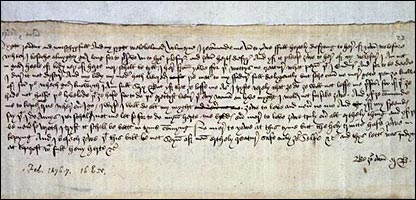
By the time of the late Medieval Period and the early Renaissance the concepts of courtly love had been fully integrated into literature and thus it is around this time period that Valentine’s Day truly began to be associated with romance. And it is thus around this time that the first dedicated Valentine poems started to appear. The earliest one that survives is a rondeau written by Charles, Duke of Orleans to his wife while he was imprisoned in the Tower of London following the Battle of Agincourt in 1415. The first words of the rondeau are:
Je suis desja d'amour tanné
Ma tres doulce Valentinée...
[“I am already sick of love, My very gentle Valentine…”]
In English, the oldest surviving valentines appear within the pages of the Paston Letters, a collection of letters and correspondence of the Pastons, a family of Norfolk gentry, and others connected to them throughout England. They were written in between the years of 1422 to 1509. These valentine letters were written by Margery Brewes in 1477 to her fiancé John Paston and were addressed to “my right well-beloved Valentine”.
William Shakespeare also referenced Valentine. In Act IV, Scene 5 of Hamlet, Valentine’s Day is mentioned in a rueful lament by Ophelia:
To-morrow is Saint Valentine's day,
All in the morning betime,
And I a maid at your window,
To be your Valentine.
Then up he rose, and donn'd his clothes,
And dupp'd the chamber-door;
Let in the maid, that out a maid
Never departed more.
At this point, Ophelia has gone mad due to Hamlet’s exile and her father’s death at Hamlet’s hand. The mention of Valentine’s Day in this context hearkens to the restrained sexuality that Ophelia had grappled with until her madness.
Another English Renaissance poet, John Donne made mention of Valentine’s Day in the opening of his epithalamium (a poem written specifically for a bride on the way to the marital chamber, in honor of the marriage of Elizabeth of Bohemia, James I’s daughter, to Frederick V, Elector Palatine, on Valentine's Day. The opening words are: Hayle Bishop Valentine whose day this is. He also ends the poem with the words, This day which might inflame thy selfe old Valentine:
Hayle Bishop Valentine whose day this is
All the Ayre is thy Diocese
And all the chirping Queristers
And other birds ar thy parishioners
Thou marryest every yeare
The Lyrick Lark, and the graue whispering Doue,
The Sparrow that neglects his life for loue,
The houshold bird with the redd stomacher
Thou makst the Blackbird speede as soone,
As doth the Goldfinch, or the Halcyon
The Husband Cock lookes out and soone is spedd
And meets his wife, which brings her feather-bed.
This day more cheerfully than ever shine
This day which might inflame thy selfe old Valentine.
The basis of this poem was once again the love birds, with the marriage of birds used as the starting point, much like Chaucer’s use of the love birds for Valentine’s two and a half centuries earlier.
In modern times, the cliché Valentine’s Day poem often starts off with the words “Roses are red and violets are blue”. The origins of this phrase date to 1590 in Sir Edmund Spencer’s epic The Faerie Queen. Within the epic, Book Three, Canto 6, Stanza 6 has the phrase:
She bath'd with roses red, and violets blew,
And all the sweetest flowres, that in the forrest grew.
While The Faerie Queen doesn’t have anything to do with Valentine’s Day per say, Spencer’s line would be the primary influence of what is considered by many to be the oldest clichéd Valentine’s Day poem:
The rose is red, the violet’s blue,
The honey’s sweet, and so are you.
Thou are my love and I am thine;
I drew thee to my Valentine:
The lot was cast and then I drew,
And Fortune said it shou’d be you.
This poem is found within Gammer Gurton's Garland, a 1784 collection of English nursery rhymes. The mention to the lot is a reference to the Roman fertility feast of Lupercalia which as stated before was believed to have been a major influence to the declaration of February 14th as Valentine’s Day (although there is little evidence to suggest such). During Lupercalia, young boys and girls were paired together through a lottery system with the intention that they would fall in love and get married. This tradition of pairing couples by lottery was continued well into the Middle Ages on every St. Valentine’s Day feast. After drawing the lots, the young men and women would then wear this name pinned to their sleeves for a week so that everyone could see. This is where the term “to wear your heart on your sleeve” originated. Women also tended to eat highly unusual food on Valentine’s Day during the Middle Ages so that they would dream about their ideal spouse.
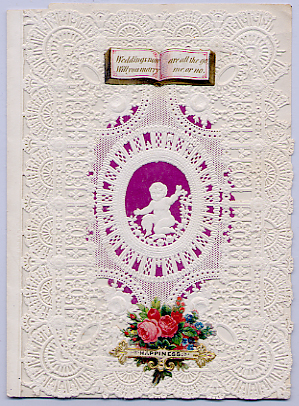
Modern Valentine's Day
It was around the time that this poem was published that Valentine’s Day was really starting to get commercialized. Around the late 18th century, a limited number of Valentine’s Cards with verses and sketches called “mechanical valentines” were being produced on printers. In 1797, a book called The Young Man’s Valentine Writer was published—it contained many verses for young men who wished to woo young women but were unable to come up with Valentine verses of their own. With the Industrial Revolution in full swing, printed Valentines became a booming industry with millions of paper Valentines being assembled in factories. In 1835 alone, 60,000 Valentines were sent throughout Britain despite how expensive postage was. That number only increased when in 1840 Uniform Penny Post was introduced which vastly reduced postage rates. Given how prudish the Victorian era was, Valentine cards were a way for young lovers to remain anonymous while having an outlet to display a certain amount of sexuality.
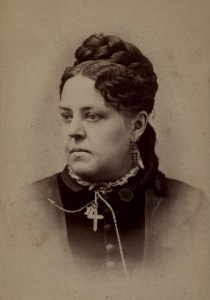
Across the pond in the United States, mass production of valentines began with Esther Howland (1828–1904) of Worcester, Massachusetts around 1847. Esther Howland is regarded by many historians as the one who shaped Valentine’s Day into what it is today, the so-called “Mother of the American Valentine”. While Howland’s father was the owner of a large book and stationary store, Howland herself was inspired by an English Valentine she received from a business associate of her father’s. She began her business by importing lace and floral decorations from England. Previous to Howland’s business, Americans had to import Valentine Cards from Europe and thus they were not easy to obtain. Perhaps that was why when Howland’s cards hit the market they became extremely successful, leading to her “New England Valentine Company” becoming a thriving industrial business. Above all, Howland is credited for the innovation of using a small brightly colored wafer of paper placed to give contrast under the white paper lace and the built-up shadow box.
As it would turn out, Valentine’s Day became the first holiday to be seriously commercialized though it would most certainly not be the last. By the mid-19th century, mass produced greetings cards had surpassed hand-written notes as the Valentine card of choice. By 1849, merely two years after Esther Howland had begun her business, Valentine’s Day had become so popular in the United States that a writer in Graham's American Monthly observed that, “Saint Valentine's Day ... is becoming, nay it has become, a national holyday.”
The first “chocolate box” was invented by Richard Cadbury in 1869 by decorating a candy box with a painting of his daughter holding a kitten. He also invented the first Valentine’s Day candy box. However, while the Cadbury’s chocolate box may have existed from 1869, it may astonish some people that the practice of exchanging gifts in addition to cards on Valentine’s Day didn’t catch on until the second half of the Twentieth Century. The most common gifts are red roses or chocolates packed into a red, satin box. Given how much roses and chocolate have come to be associated with Valentine’s Day, the fact that this is such a new tradition might be a surprise for some. Furthermore, it wasn’t until the 1980s that the diamond industry began promoting Valentine’s Day as a day to give jewelry as a gift.

Valentine's Day Today
Today, Valentine’s Day is the forefront of several billion dollar industry. The US Greeting Card Association estimates that about 190 million are sent each year within the United States with about half of those given to family members other than the spouse, usually children. When valentine cards that are made in school are included, that number shoots up to one billion. If these valentines for family members such as children and those that are made in school are excluded then Hallmark’s research shows that about 141 million cards are exchanged annually, making it the second-most popular greeting-card holiday after Christmas. Hallmark’s research also shows that over fifty percent of all Valentine’s Day cards are purchased during the six days prior to February 14th and that more than half of the US population celebrates Valentine’s Day by purchasing a card.
In days leading up to Valentine’s Day, sales of flowers and candy, especially roses and chocolate, tend to increase by about 10 to 12 percent. According to NRF reports, of all the people buying gifts for Valentine’s Day, 36.6% of them will buy flowers. In 2012 during quarter that contains February, 1-800-Flowers $91.8 million in flowers. At the same time the Hershey Company $1.66 billion in candy, especially chocolate. During the week leading up to Valentine’s Americans will purchase about 60 million pounds of chocolate and about seventy-five percent of it will be given by men to women. Tiffany & Co. also made large strides due to about 19.7% of American consumers buying jewelry on Valentine’s with revenue exceeding $4.4 billion.
Valentine Flowers from Amazon
Flowers, especially roses have had a long association with Valentines. Of course, they are referenced in the 1784 nursery rhyme in Gammer Gurton's Garland. But there are some legends, or rather an embellishment of a legend, that dates the association of the rose all the way back to St. Valentine of Terni. This embellishment is that in addition to the Valentine he sent to his jailer’s daughter shortly before his martyrdom, the saint also sent a single red rose. In the past, red roses were regarded by Christians as a symbol of martyrdom. More commonly, it is regarded as a symbol of love and beauty and thus giving someone a red rose is regarded as a sign of deep love for that person. About 110 million roses will be sold during the three days leading up to February 14th, most of them imported from South America. An alternative to the red rose is a red or yellow tulip, also a symbol of love. Valentine’s Day and Mother’s Day are the two holidays where the most flowers are purchased. Men purchase about 73% of all flowers while women purchase only about 27%.
Chocolate’s association with Valentine’s Day probably stems from the general perception of chocolate being considered by many to be some form of aphrodisiac, and has been regarded as such since the days of the Aztecs. While this notion is debatable, what chocolate does in fact do is stimulate the release of endorphins in the brain. This could easily have been the phenomena that convinced people that chocolate was a form of aphrodisiac. Today, there is a general cultural perception that women crave chocolate (though not necessarily true) which ties into why so many men give it to women on this day. About 75% of all chocolates purchased in the United States during the valentine season are purchased by men. On the other hand, about 85% of Valentine cards are purchased by women.
In recent years, Fenruary 15th has come to be known as ‘Singles Awareness/Appreciation Day”. It is regarded as an alternative holiday for singles or those not involved in a romantic relationship. While it is usually meant to be a holiday celebrated in good humor, some singles “celebrate” it out of spite for Valentine’s Day. Typically on Singles Awareness Day, singles would often get together to celebrate or to commiserate on their single status. They usually wear green on this day since it falls opposite of red on the color wheel. Another option is black to symbolize an absence of celebration. The idea of Singles Awareness Day is that you don’t need to be in a romantic relationship to celebrate life.
Valentine's Around the World
Globally, most Western European countries still celebrate St. Valentine’s Day as a feast that celebrates the Roman martyr, like in the days of old. All of the romantic traditions are still present but it all falls behind the backdrop of the traditional feast. The St. Valentine’s Day Feast is today recognized as an official feast day by the Roman Catholic Church, the Anglican Church, and the Lutheran Church. Eastern European nations for the most part often have their own traditional feasts where love is expressed. However, a good many of these countries have also adopted the global form of Valentine’s Day as well. For the rest of the world however, while Valentine’s Day is celebrated on February 14th it is rarely regarded as an actual holiday. In these places a variation of the largely secular Valentine’s traditions that developed in the United States are often observed, especially in East Asia.
In China, Valentine’s Day on February 14th is not celebrated since the date usually falls too close to the Chinese New Year. Instead, the Chinese have their own equivalent; the “Chinese Valentine’s Day” Qixi (七夕) Festival which is celebrated on the seventh day of the seventh month of the lunar calendar (usually mid-August). Qixi is a commemoration of the day when the legendary cowherder and weaving maid are allowed to be together. It is on this day that a Chinese man will give chocolate, flowers, or both to the woman he loves. In recent years, White Day has also started to become popular amongst younger generations in China as well.
Speaking of White Day, in Japan Valentine’s Day is essentially spread over two dates: February 14th Valentine’s Day, and March 14th White Day. Valentine’s Day was first acknowledged in Japan in 1936 when Morozoff Ltd. ran an advertisement for foreigners. Years later in 1953, Morozoff began promoting the giving of heart-shaped chocolates and other confectionery companies soon followed. By the 1960s, all of these marketing campaigns had popularized the holiday in Japan.
There is a common Japanese custom that only women give men chocolate on Valentine’s Day. This seems to have arisen from a translation error during the initial campaigns that popularized the holiday. Either way, Valentine’s Day in Japan is all about the woman giving the man the right amount and the right type of chocolate—all other common Valentine’s traditions such as cards, flowers, candies, or dinner dates are rather uncommon. Women are obligated to give chocolates to male co-workers and friends: these are called giri-choco (義理チョコ), the word “giri” meaning “obligation”. How much the woman likes the male co-worker is often reflected in the quality of the chocolate given with the unpopular ones receiving cheap, low quality chocolate. Giri-choco are contrasted to honmei-choko (本命チョコ, favorite chocolate), the chocolate given to the one they love.
During the 1980s the Japanese National Confectionery Industry Association started a campaign to designate March 14th as a “reply day” where the men who received honmei-choko were expected to return the favor with gifts for the women who gave them the chocolate. The campaign for this day White Day became a full-fledged success. The name comes from the fact that white chocolate had become a popular gift to give on that day. On White Day, the quality of the gift given works as a form of communication, a reply. If the man doesn’t return a gift, this means he views himself as a superior to the woman which can actually be considered insulting to the woman. If the man returns a gift of equal value, that means he is ending the relationship. If the gift returned is of higher value than the chocolates received, that means the man reciprocates the woman’s feelings. In addition to Valentine’s Day, Japan also has its own version of Qixi called “Tanabata” which has been observed on July 7th for centuries. Unlike China with Qixi however, Japan has not added any Valentine traditions to Tanabata.
South Korea essentially follows all of Japan’s Valentine customs and ups them to eleven. Koreans observe the same customs of women giving chocolate to men on Valentine’s Day and men replying with non-chocolate gifts on White Day. Only, Korean women tend to give much larger amounts of chocolate than their Japanese counterparts. Furthermore, the Koreans have also designated April 14th as “Black Day”—on this day those who did not receive anything on February 14th or March 14th will go out to a Korean restaurant and “mourn” their singleness by eating black noodles (자장면 jajangmyeon); quite similar to Singles Awareness Day in the west. There is also November 11th, Pepero Day where young couples celebrate by giving each other Pepero cookies. Overall, the Koreans and the Chinese sped the most money on Valentine’s Day.
Other East Asian countries have developed their Valentine traditions as well. In Taiwan, the same Valentine’s Day and White Day combination that started in Japan is also celebrated. However, it is in reverse: Valentine’s Day is the day that men give gifts to loved ones, and White Day is the day that women give their gifts n reply to what they received on Valentine’s. The residents of Singapore tend to be amongst the biggest spenders around Valentine’s Day with sixty percent of Singaporeans spending anywhere in between $100 to $500 during the season. In the Philippines the day is called Araw ng mga Puso ("Hearts Day") and is celebrated much like it is in the west. This day is usually marked by a sharp increase in the price of flowers, especially red roses.
Moving away from Asia, in Latin America a lot of countries celebrate Valentine’s Day as “Día del Amor y la Amistad” (The Day of Love and Friendhip). In addition to all of the romantic traditions associated with the celebration of your significant other, residents of Latin America also celebrate friendship on this day with “acts of appreciation” for their friends. This is the case in Latin American countries such as Ecuador, Mexico, Colombia, the Dominican Republic, Costa Rica, and Puerto Rico. These countries also usually celebrate Amigo secreto (“Secret friend”) together with “Día del Amor y la Amistad” on February 14th, other than Colombia which celebrates “Amigo secreto” on the third Saturday of September. The tradition of “Amigo secreto” is that each participating recipient will receive an anonymous gift, much like the Secret Santa tradition in the west.
The exception to all of this is Brazil. In Brazil Dia dos Namorados (“Lovers' Day” or “Boyfriends’/Girlfriends’ Day”) is celebrated on June 12th, the eve of St. Anthony’s Day. St. Anthony is known as the marriage saint in Brazil and it is on June 12th that single women perform the traditional rituals of simpatias in order to find a good husband or boyfriend. Couples who are already together on this day celebrate by exchanging gifts, chocolates, flowers, and cards. As for Valentine’s Day, there is no celebration on February 14th whatsoever. This is most likely because the day falls a little too close to the Brazilian Carnival, either too soon before or too soon after. Due to the lack of Valentine’s celebrations as well as the celebrations of the Carnivals, Brazil becomes a popular tourist destination during mid-February for western singles who want to get away from the holiday, usually as a treat for Singles Awareness Day.
In India and Iran, Valentine’s Day has been gaining more and more popularity over the traditional day of love of Esfandegan in Iran, and the taboo against public displays of affection in India. This has resulted in a movement from traditionalists to oust the holiday, regarding it as a cultural contamination from the west though so far with very little success. The same is happening in Pakistan and Malaysia as well where political Muslims have been calling for the banning of the holiday with little success. In Saudi Arabia, the holiday is outright banned. The Saudi’s go as far as to ban the wearing of red on February 14th. In the case of Israel on the other hand, the traditional holiday Tu B’Av was revived and transformed as a Jewish equivalent of Valentine’s Day and is celebrated on the 15th of Av (usually late August). Valentine’s Day and Tu B’Av have easily co-existed with each other in Israel and both holidays are popularly regarded as a time for couples to express their love.
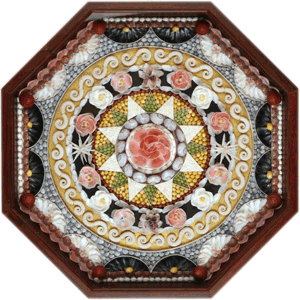
Sailor's Valentine
Stepping away from geography and going back into history, one popular form of Valentine’s Craft created during the nineteenth century (in between 1830 and 1890) was the Sailor’s Valentine. These were shellcraft, an antique souvenir made of multiple seashells and were designed to be brought home to a sailor’s loved one or loved ones after a long sea voyage. They are usually octagonal, fitted with glass within hinged wooden boxes and ranged in about eight to fifteen inches in diameter. While the name suggests that sailors themselves made them, it seems more likely that they came from the island of Barbados. According to historians, local women constructed the Sailor’s Valentines using local shells or occasionally shells imported from Indonesia, and then sold them to visiting sailors.
February 14th in History
History is filled with many incidents that took place on February 14th that don’t necessarily have anything to do with Valentine’s Day itself. February 14th, 1778, the United States flag was formerly and officially recognized with a nine-gun salute as John Paul Jones’s USS Ranger sailed into port in France. February 14th 1797, Captain Horatio Nelson first distinguished himself in the Battle of Cape St. Vincent. In 1849, James Polk became the first serving US President to have his photograph taken. In 1855, Texas is connected to the rest of the United States via telegraph. On this date in 1859, Oregon was admitted into the Union as the thirty-third state. On this day in 1876, both Alexander Graham Bell and Elisha Gray apply separately for the patent of the telephone, with the Supreme Court eventually awarding it to Bell. On this day in 1895, Oscar Wilde’s “Importance of Being Earnest” first opened in London. On this day in 1899, President McKinley legalized mechanical voting machines. On this day in 1912, Arizona was admitted into the Union as the forty-eighth state.
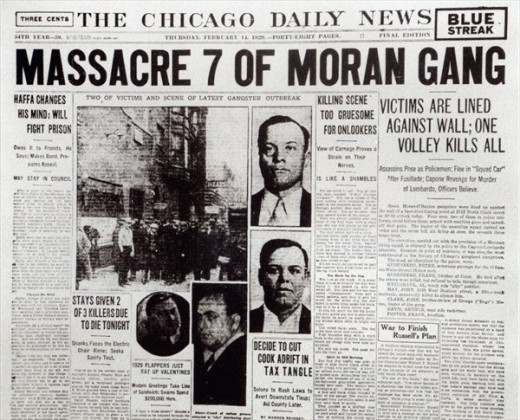
Perhaps the most famous historical event to take place on this day would be the St. Valentine’s Day Massacre of 1928. As a lot of people know, this slaughter arose out of the prohibition-era mob rivalry between George “Bugs” Moran’s North Side Irish gang and Alphonse “Scarface” Capone’s South Side Italian gang. The Capone and Moran gang had been rivals in the control of Chicago’s underground bootlegging business for years. Add to that, several violent episodes between the two or between their associates and tensions between the two rival gangs were at an all time high. The South Side Gang had already assassinated the North Side Gang’s previous leader Dean O’Banion in 1924 and Moran had already ordered two attempts on Capone’s life in retaliation and had many of Capone’s close friends murdered.
In 1929, Capone ordered Moran’s assassination. On February 14th, 1929, Capone’s gang sent out some misinformation about one of their bootlegged shipments in an attempt to lure Moran into a trap in the SMC Cartage warehouse at 2122 North Clark Street. Five of Moran’s men and two collaborators were already there when four of Capone’s men arrived disguised as policemen. Conducting a “raid”, the “police” lined the seven North Side gangsters along the wall, and promptly emptied their tommy guns into them. Ironically, the assassination’s main target Bugs Moran wasn’t there, having noticed the “police” and thinking a raid was going on retreated to a coffee shop. Most likely, Capone’s men had mistaken one of Moran’s men, Albert Weinshank, for Moran himself and thus gunned them down despite Moran not being there. Of course, public outcry against the St. Valentine’s Day Massacre would essentially prove to be catalyst of what would eventually lead to the downfall of both Al Capone and Bugs Moran. Fun fact, on the exact same day the St. Valentine’s Day massacre took place, February 14th, 1929, Penicillin was introduced to the world.
In Canada, an event called the Women’s Memorial March takes place every February 14th to call attention to missing and murdered women. Originally starting in Vancouver in 1992, the event has spread to other Western Canadian cities since then. In particular, the Women’s Memorial march places emphasis on the violence against Native American women. February 14th is also the time when the V-day global activist movement to end violence against women and girls takes place. The V-day movement was inspired by Eve Ensler’s play The Vagina Monologues and was started by Ensler in 1998. V-day’s mission is a call to end all forms of violence from rape to sexual slavery against women. However, V-day has been criticized for its methods and has been described as a misandrist feminist movement that has hijacked the celebration of love and romance on Valentine’s Day.
Valentine Superstitions
As can be expected of a popular holiday, there have been a lot of superstitions that have risen concerning Valentine’s Day. For example, it is said that the kind of bird a girl sees on Valentine’s Day will predict what kind of man she will marry: if it’s a sparrow she will marry a poor man, a blackbird a priest or clergyman, a bluebird a happy man, a crossbill and argumentative man, or if an owl she will remain a spinster. If she sees a goldfinch she will marry a millionaire, if she sees a robin she will marry a crime fighter, or a flock of doves then she will have a happy, peaceful marriage. Then again, if she sees not a bird but rather a squirrel, she will end up married to a money hoarding cheapskate. There are other superstitions such as how if you are awoken with a kiss on Valentine’s Day it is considered lucky, how if you cut an apple in half on Valentine’s Day the number of seeds you find will indicate the number of children you will have, how the first guy’s name you read in the newspaper or hear on the TV or Radio on Valentine’s Day will be the name of the man you will marry, how if you find a glove on the road on Valentine’s Day your future beloved will have the other glove, etc. We could go on and on with all of these superstitions.
That is essentially the gist of St. Valentine’s Day. From the mysteries of the men named St. Valentine, to the origin of the feast to commemorate him. From the how Valentine’s Day came to be associated with love and romance and how the notion developed during the Medieval and Renaissance periods. We’ve examined how the modern holiday took shape and the details of the commercial aspects behind the date, how the date is celebrated around the world or how alternative festivals take place. We’ve seen some important historical events that took place on Valentine’s Day and even took a look at some of the superstitions. All-in-all, St. Valentine’s Day is about love and celebrating those whom you love and love you in return. Some long as there is someone for you to love there is always a celebration much like those that take place on St. Valentine’s Day.
Valentine's Gift Poll
What gifts do you like to give on Valentine's day?
Sources
- Valentine's Day - Wikipedia, the free encyclopedia
- Valentine Exhibition-- Origins of the Valentine
- Valentine's Day - Facts, Origin, Meaning & Videos - History.com
Find out more about Valentine's Day, including the story of its origin, symbols, and traditions. Get all the facts on History.com. - St. Valentine's Skull/ Atlas Obscura
Here lies the head of the patron saint of lovers -- or does it?

